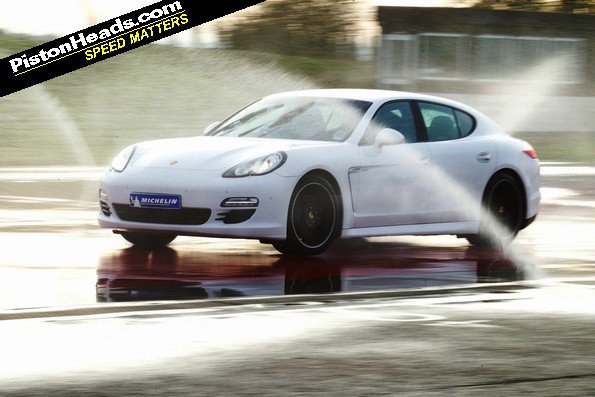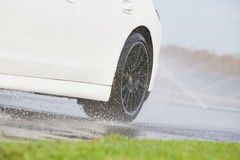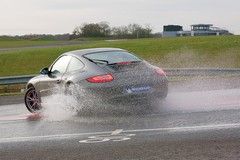Feature: Winter tyres - worth the bother?
It's turning frosty - should you be changing your rubber to compensate?

The deal was simple enough. Head up to Silverstone and the Porsche Experience Centre and experience various driving exercises on the facility's wet, dry and low-grip handling surfaces with and without winter tyres to see if they really do make a difference. Winter tyres? Sorry, according to Michelin we're supposed to refer to them as cold-weather tyres. But seeing as cold weather, on the whole, occurs in winter ... you can see where we're going with that.
Anyway, as you'll know the official line is that the tyres work best in conditions below seven degrees without any additional wear occurring. And while it's been pretty mild up until now if you were thinking of trying winter rubber this year, now would be the time to make it happen. It's quite an investment of course, a Pilot Alpin cold weather tyre in the most commonly sold 205/55R16 size costing £106 and its equivalent Pilot Sport 3 'summer' tyre coming in at £89. Add in the cost of another set of wheels and you'd be lucky to get rolling for much less than £700. So should you be bothering?
The proof is in the driving, of course, and for this quick snapshot Porsche and Michelin laid on a number of exercises in a before-and-after format, with cars running regular tyres and the cold weather equivalents. These included a standing start test on the 'ice hill', the wetted resin surface carrying off a passing impression of black ice. This was conducted in a Cayenne on summer tyres and a Boxster on winters to demonstrate how four-wheel drive isn't necessarily any use if you can't get the power down. Cayennes also featured for the dry handling run around the twisty, technical test track before swapping to Panameras on both types of tyre on the kickplate, which flicks the back of the car out as you enter a low-grip surface to simulate a sudden loss of control.
Tyre companies like Michelin are obviously keen to drive sales of winter rubber and, especially after last winter's conditions, are counting on a greater awareness to increase demand. We're still way behind our European neighbours though, 45% of Germans going for winter rubber against just 0.4% of Brits. Continental is the market leader, Michelin not far behind with Goodyear and other big names like Nokian and Pirelli accounting for the bulk of the rest. With European sales of 60 million units you can see why they're keen for us to get the winter tyre habit too.
But is there any point? All very well you having the grip to keep going but if the roads are gridlocked what good has it done? And you might be able to stop in time, but what about the person behind you who's about to use you as their crumple zone?
It's something to weigh up and, if you live out in the sticks and simply can't afford to get stuck, now may be the time to make the switch. But what about our winners?
Over to our two tame PHers...
Nigel Parker
Nigel Parker thought he'd enter the competition based on the fact "I'm pretty much a tyre nerd!" His words, not ours but a man with two very nice Subarus - a MY2000 Impreza STI Wagon and a treasured low-mileage 1997 Type R WRX - and a rural commute can't be blamed for taking an interest in winter rubber. Surely a Scooby is enough though? "With a Subaru you've got the traction to pull away," he says, "but once you're moving you're pretty much with everyone else, especially under braking."
Wise words and, after having his beloved Wagon nearly wiped out by a slithering hot hatch, Nigel was keen to see if cold weather tyres lived up to the hype. Did they? "I've never tried them before but in the past couple of years I've heard people saying how good they were - though I never considered making the jump because we only have snow a couple of times a year," he says. "But I've now realised it's not just the snow but the cold weather in general where they can help. The difference on the kick plate and the ice simulation was amazing." Amazing enough to invest in a set? Enough to have him thinking about it.
Simon Fisher
Working at a BMW dealership, Simon Fisher knows a thing or two about how badly some cars cope with wintry conditions. No news report from last winter's snow was complete without a slithering BMW and, as a result, Simon's got a head start on consumer demand for winter tyres. "We had people spending £1700 on a set of winter tyres and wheels and I was never really sure if they made that much difference," he admits.
A session on the kickplate with the Panamera was enough to convince him, though. "With the winter tyres I was able to stop but with the summer ones I just slid until I reached the dry tarmac at the end," he says. Aware of the negative PR BMWs had in the wintry weather dealerships like his will store summer wheels as an added incentive for owners considering the swap to seasonal rubber. Seasonal as in cold weather-appropriate, not with tinsel on the sidewalls. Though that might be a nice idea. Moving on, what was the biggest revelation from the session at Silverstone? "The way you could just drive normally with the Carrera 2 on the ice hill with the winter tyres on," he says. So will he be getting a set for his Starlet Turbo? Not until the sizes become available but, in principle, he's sold.
Last winter, even on just above minimum legal tread, the Discovery was faultless in traction. the "grass, gravel & snow" setting on the transmission alters the diff, gearbox and throttle to near perfect settings and progress is laughably easy in snow. However, you need to plan ahead for braking.
I'm very interested by the comments regarding the effectivenss of winter tyres. I will be watching, if and when we get snow at home, to see whether my neighbour's Merc CLS (now on fresh winter rubber) will be stranded again, as final proof.
Gassing Station | General Gassing | Top of Page | What's New | My Stuff








